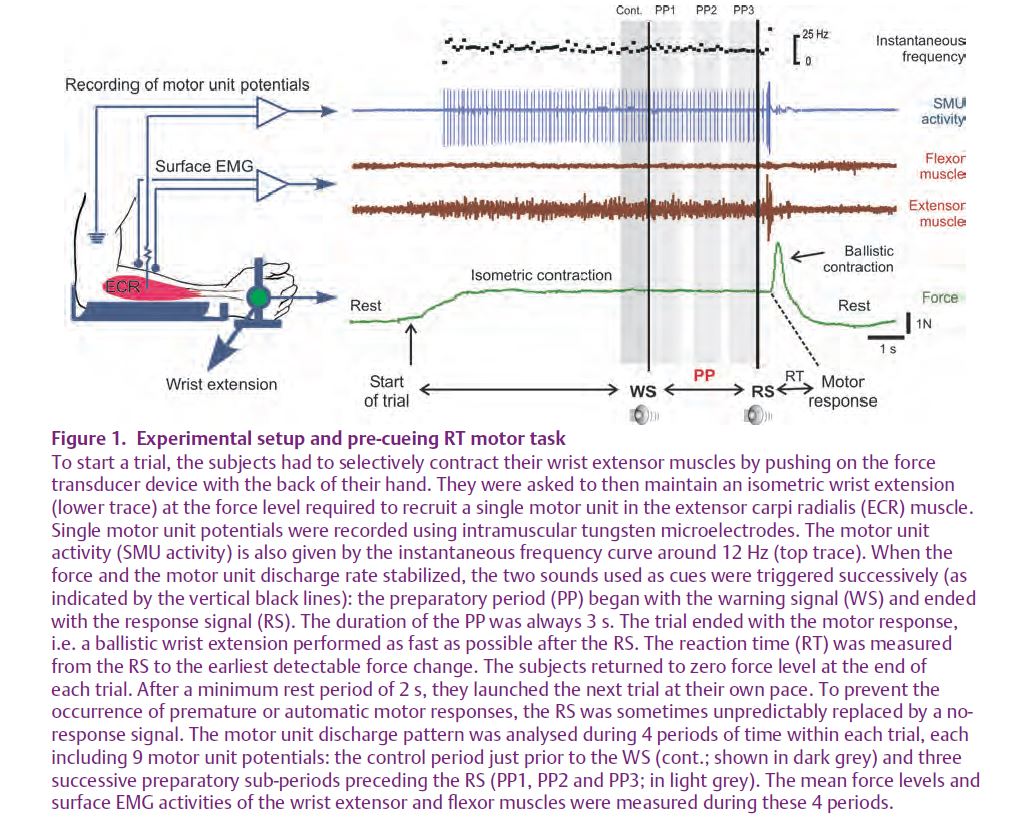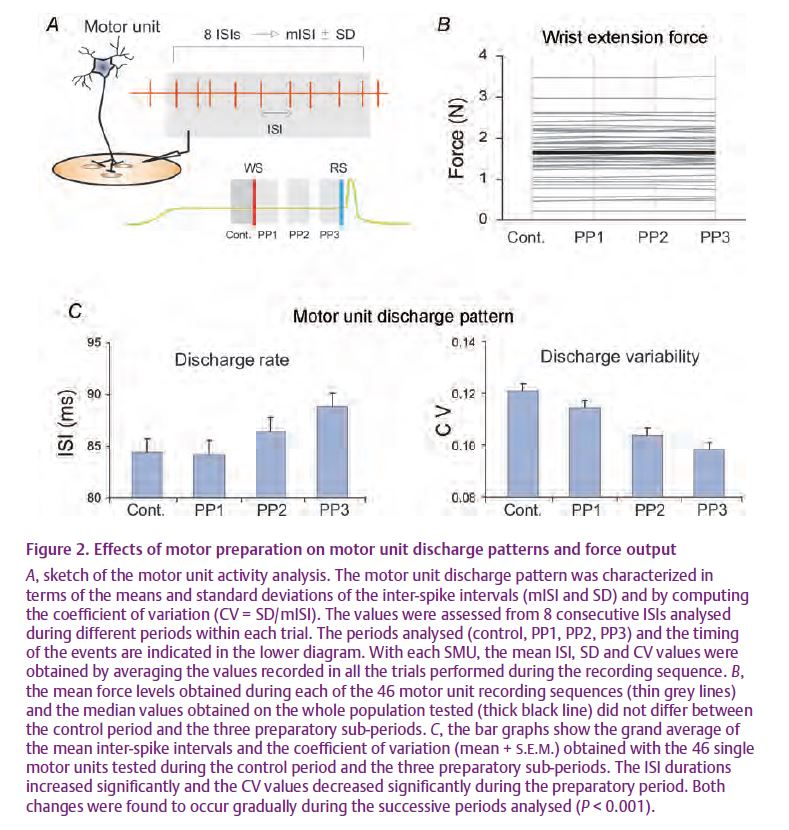
Physiology News Magazine
When motoneurons get ready: new insights into motor preparation
Advance information about forthcoming motor actions helps to prepare for rapid movement execution by triggering changes in neuronal activity a few hundreds of milliseconds before a movement is actually performed. These preparatory processes have been found to occur at many levels in the motor system, from the motor cortex to the spinal cord. We recently obtained evidence that even motoneurons, which are the most peripheral components in the spinal cord, respond in this way to advance information
Features
When motoneurons get ready: new insights into motor preparation
Advance information about forthcoming motor actions helps to prepare for rapid movement execution by triggering changes in neuronal activity a few hundreds of milliseconds before a movement is actually performed. These preparatory processes have been found to occur at many levels in the motor system, from the motor cortex to the spinal cord. We recently obtained evidence that even motoneurons, which are the most peripheral components in the spinal cord, respond in this way to advance information
Features
Yann Duclos (1), Annie Schmied (1), Boris Burle (2), Henri Burnet (1) and Christiane Rossi-Durand (1)
1: Laboratoire de Plasticité et Physio-Pathologie de la Motricité (P3M), UMR 6196, Aix-Marseille Université/CNRS, Marseille, France
2: Laboratoire de Neurobiologie de la Cognition (LNC), UMR 6155, Aix-Marseille Université/CNRS, Marseille, France
https://doi.org/10.36866/pn.74.37

The execution of an accurate voluntary movement requires the underlying motor command to be continually adjusted to match the changing demands of the behav-ioural context as quickly as possible. The motor system therefore has to assess the ongoing context and predict the various changes liable to occur in order to be ready to react immediately. The appropriate adjustment of the motor command to the requirements of the forth-coming motor task is mainly based on motor preparation.
Many studies on humans and other primates have focused on the central processes involved in motor preparation, using pre-cueing reaction time tasks. In these tasks, the voluntary command is triggered by a stimulus, the response signal (RS). Before the instruction to move is given by the RS, a warning signal (WS) provides the subject with advance information about the movement to be performed. It has been clearly established that prior information of this kind contributes to improving motor performances by shortening the time required to react to the RS, i.e. the reaction time (RT). In particular, when the WS provides information about the timing of the forthcoming RS, it helps the subject to be ready at the right time.
Single neuron recordings performed on awake monkeys trained to perform pre-cueing RT motor tasks showed that changes in the neural activity of many supraspinal motor structures occurred during the preparatory period (PP), which is the interval between the two signals (WS and RS). These changes therefore occur up to several hundreds of milliseconds before the onset of the response signal (see Riehle, 2005 for a review). There now exists evidence that preparatory processes are triggered at various levels in the motor system, including not only the primary motor cortex involved in shaping the motor command to be transmitted to the spinal motor networks, but also the spinal cord itself. Experiments using the Hoffman reflex and transcranial magnetic stimulation (TMS) on humans performing RT tasks have shown that changes in the excit-ability of spinal motor networks occur during the preparatory period in response to both central and peripheral afferent inputs (Bonnet et al. 1981; Touge et al. 1998; Hasbroucq et al. 1999). The idea that preparatory processes occur at the pre-motoneuronal level has been supported by data on awake monkeys showing the occurrence of changes in the firing rates of spinal interneurons, which were specifically associated with prior information about the movement parameters
(see Fetz et al. 2002 for a review).

We recently addressed the question as to whether or not these changes in pre-motoneuronal activity occurring during motor preparation may also include motoneuronal activity (Duclos et al. 2008). For this purpose, the effects of motor preparation on motoneuron activity were studied in humans by combining single motor unit recording techniques with reaction-time methods. The pattern of human motoneuron activity can indeed be deduced from intra-muscular recordings of single motor unit activity, since there exists a one-to-one relationship between the action potentials generated by the motoneurons and the muscle fibres they innervate. The tonic activity of wrist extensor motor units associated with voluntary isometric contractions was analysed during preparation for a ballistic wrist extensor muscle contraction, using a time preparation procedure in which the warning signal preceded the response signal by 3 s (Fig. 1). The changes observed in the motor unit tonic discharge pattern during the preparatory period show that the motoneurons are involved in motor preparation. The rate and the regularity of the motoneuron discharge patterns were consistently altered prior to the response signal and showed a slight lengthening of the mean inter-spike interval (ISI) and a marked decrease in the ISI variability (Fig. 2C). The lengthening of the inter-spike interval confirms that inhibitory mechanisms are activated during motor preparation. The finding that the slowing down of the motoneuron discharge rate during the preparatory period was concomitant with a decrease in the discharge variability was unexpected. It indicates that the integrative properties of moto -neurons may be modulated during motor preparation, possibly as the result of spinal inhibitory mecha-nisms. These changes in motoneuron activity occurred gradually during the successive periods analysed and were most prominent at the end of the 3 s preparatory period. This time course suggests that the activation of these inhibitory mechanisms may be associated with the timing of the forthcoming response signal and may possibly serve to prevent premature motor output from occurring.

These data showing that the activity of motoneurons was modulated prior to the onset of a response signal provide evidence that anticipatory changes occur in motoneuron activity, just as they do in the neural activity of many supraspinal motor structures. This means that some central influences act on spinal motoneurons during preparation for action, i.e. well before it is time to act. The fact that no changes were detected in the force output during the preparatory period (Fig. 2B) confirms that the anticipatory changes in motoneuron activity were subtle enough to prevent any unwanted changes in muscle contraction from occurring prior to the instruction to move.
The finding that advance information may influence the state of the motor system, including even the most peripheral motor neurons in the spinal cord, supports the idea that motor preparation involves distributed processes, in line with the conclusion reached by Fetz’s group (Prut et al. 2001 for a review).
References
Bonnet M, Requin J & Semjen A (1981). Human reflexology and motor preparation. Exerc Sport Sci Rev 9, 119–157.
Duclos Y, Schmied A, Burle B, Burnet H & Rossi-Durand (2008). Anticipatory changes in human motoneuron discharge patterns during motor preparation. J Physiol 586, 1017–1028.
Fetz EE, Perlmutter SI, Prut Y, Seki K & Votaw S (2002). Roles of primate spinal interneurons in preparation and execution of voluntary hand movement. Brain Res Brain Res Rev 40, 53–65.
Hasbroucq T, Osman A, Possamai CA, Burle B, Carron S, Depy D, Latour S & Mouret I (1999). Cortico-spinal inhibition reflects time but not event preparation: neural mechanisms of preparation dissociated by transcranial magnetic stimulation. Acta Psychol (Amst) 101, 243–266.
Prut Y, Perlmutter SI & Fetz EE (2001). Distributed processing in the motor system: spinal cord perspective. Prog Brain Res 130, 267–278.
Riehle A (2005). Preparation for action: one of the key functions of motor cortex. In Motor Cortex in Voluntary Movements: a Distributed System For Distributed Functions, ed. Riehle A & Vaadia E, pp. 213–240. CRC Press, Boca Raton, FL, USA.
Touge T, Taylor JL & Rothwell JC (1998). Reduced excitability of the cortico-spinal system during the warning period of a reaction time task. Electroencephalogr Clin Neurophysiol 109, 489-495.
